Method for Distinguishing Sargassum and Zostera in the Seto Inland Sea Using Sentinel-2 Data
Abstract
:1. Introduction
2. Materials and Methods
2.1. Study Area
2.2. Separation Method of Sargassum and Zostera Using Satellite Data
2.3. Field Spectral Reflectance Data Sampling
2.4. Satellite Data Used and Preprocessing Method
2.5. Digital Water Depth Data
3. Result
3.1. Extraction Coefficient of Study Area
3.2. Overview of Sargassum and Zostera Appearance
3.3. Proposal of a Method Distinguishing between Sargassum and Zostera
3.4. Validation of the Sargassum and Zostera Distinguish Index
4. Discussion
4.1. Validity of Underwater Forest Area Selection Using Bottom Index
4.2. Spectral Characteristics of Zostera and Sargassum
4.3. Validity and Limitations of the SZDI Method
5. Conclusions
- The BI method was an effective method, using a combination of Band 3 (green) and Band 4 (red) Sentinel-2 data for estimating the area of SWSG beds in the sea.
- The spectral reflectance characteristics of Sargassum and Zostera measured on site were understood. In general, the characteristics exhibit low reflectance in the blue and red bands for both Sargassum and Zostera, but exhibit relative high reflectance in the green band for Zostera.
- The SZDI, which used the height from the background of Sentinel-2 Band 3 (560 nm) as an index, was proposed as a method for separating Sargassum and Zostera. Its validity was confirmed through field surveys, the examination of past SWSG bed maps, and the consideration of biological characteristics.
Author Contributions
Funding
Institutional Review Board Statement
Informed Consent Statement
Data Availability Statement
Acknowledgments
Conflicts of Interest
References
- Smith, S.V. Marine Macrophytes as a Global Carbon Sink. Science 1981, 211, 838–840. [Google Scholar] [CrossRef] [PubMed]
- Greiner, J.T.; McGlathery, K.J.; Gunnell, J.; McKee, B.A. Seagrass Restoration Enhances “Blue Carbon” Sequestration in Coastal Waters. PLoS ONE 2013, 8, e72469. [Google Scholar] [CrossRef] [PubMed]
- Lavery, P.S.; Mateo, M.-Á.; Serrano, O.; Rozaimi, M. Variability in the Carbon Storage of Seagrass Habitats and Its Implications for Global Estimates of Blue Carbon Ecosystem Service. PLoS ONE 2013, 8, e73748. [Google Scholar] [CrossRef] [PubMed]
- Tokoro, T.; Hosokawa, S.; Miyoshi, E.; Tada, K.; Watanabe, K.; Montani, S.; Kayanne, H.; Kuwae, T. Net Uptake of Atmospheric CO2 by Coastal Submerged Aquatic Vegetation. Glob. Chang. Biol. 2014, 20, 1873–1884. [Google Scholar] [CrossRef]
- Ministry of the Environment. Available online: https://www.env.go.jp/water/heisa/setonaikai_law_rev.html (accessed on 9 November 2023).
- Yamamoto, T. The Seto Inland Sea––Eutrophic or Oligotrophic? Mar. Pollut. Bull. 2003, 47, 37–42. [Google Scholar] [CrossRef]
- Imai, I.; Yamaguchi, M.; Hori, Y. Eutrophication and Occurrences of Harmful Algal Blooms in the Seto Inland Sea, Japan. Plankton Benthos Res. 2006, 1, 71–84. [Google Scholar] [CrossRef]
- Takeoka, H. Progress in Seto Inland Sea Research. J. Oceanogr. 2002, 58, 93–107. [Google Scholar] [CrossRef]
- Dierssen, H.M.; Zimmerman, R.C.; Leathers, R.A.; Downes, T.V.; Davis, C.O. Ocean Color Remote Sensing of Seagrass and Bathymetry in the Bahamas Banks by High-Resolution Airborne Imagery. Limnol. Oceanogr. 2003, 48, 444–455. [Google Scholar] [CrossRef]
- Traganos, D.; Reinartz, P. Mapping Mediterranean Seagrasses with Sentinel-2 Imagery. Mar. Pollut. Bull. 2018, 134, 197–209. [Google Scholar] [CrossRef]
- Lyzenga, D.R. Passive Remote Sensing Techniques for Mapping Water Depth and Bottom Features. Appl. Opt. 1978, 17, 379. [Google Scholar] [CrossRef]
- Lyzenga, D.R. Remote Sensing of Bottom Reflectance and Water Attenuation Parameters in Shallow Water Using Aircraft and Landsat Data. Int. J. Remote Sens. 1981, 2, 71–82. [Google Scholar] [CrossRef]
- Philpot, W.D. Bathymetric Mapping with Passive Multispectral Imagery. Appl. Opt. 1989, 28, 1569. [Google Scholar] [CrossRef] [PubMed]
- Stumpf, R.P.; Holderied, K.; Sinclair, M. Determination of Water Depth with High-Resolution Satellite Imagery over Variable Bottom Types. Limnol. Oceanogr. 2003, 48, 547–556. [Google Scholar] [CrossRef]
- Biodiversity Center of Japan. Available online: https://www.biodic.go.jp/moba/1_1.html (accessed on 20 September 2023). (In Japanese)
- Gower, J.; Hu, C.; Borstad, G.; King, S. Ocean Color Satellites Show Extensive Lines of Floating Sargassum in the Gulf of Mexico. IEEE Trans. Geosci. Remote Sens. 2006, 44, 3619–3625. [Google Scholar] [CrossRef]
- Hu, C. A Novel Ocean Color Index to Detect Floating Algae in the Global Oceans. Remote Sens. Environ. 2009, 113, 2118–2129. [Google Scholar] [CrossRef]
- Gower, J.F.R.; King, S.A. Distribution of Floating Sargassum in the Gulf of Mexico and the Atlantic Ocean Mapped Using MERIS. Int. J. Remote Sens. 2011, 32, 1917–1929. [Google Scholar] [CrossRef]
- Hu, C.; Feng, L.; Hardy, R.F.; Hochberg, E.J. Spectral and Spatial Requirements of Remote Measurements of Pelagic Sargassum Macroalgae. Remote Sens. Environ. 2015, 167, 229–246. [Google Scholar] [CrossRef]
- Yoshida, T. Japanese species of Sargassum subgenus Bactrophycus (Phaeophyta, Fucales). J. Fac. Sci. Hokkaido Univ. Ser. 5 Bot. 1983, 13, 99–246. [Google Scholar]
- Yoshida, G.; Hori, M.; Sakiyama, K.; Hamaguchi, M.; Kajita, A.; Nishimura, K.; Shoji, J. Distribution of Seaweed Bed and Tidal Flat and Their Correlations with Fisheries Catches in the Nine Sea Areas of the Seto Inland Sea. Fish. Eng. 2010, 47, 19–29. [Google Scholar]
- Albert, A.; Mobley, C. An Analytical Model for Subsurface Irradiance and Remote Sensing Reflectance in Deep and Shallow Case-2 Waters. Opt. Express 2003, 11, 2873. [Google Scholar] [CrossRef]
- Odagawa, S.; Takeda, T.; Yamano, H.; Matsunaga, T. A Proposed Method for Estimation of Cover Degree for Each Bottom-Type in Coral Reef Areas Using Hyperspectral Data. J. Remote Sens. Soc. Jpn. 2016, 36, 1–10. [Google Scholar] [CrossRef]
- Morel, A.; Prieur, L. Analysis of Variations in Ocean Color1. Limnol. Oceanogr. 1977, 22, 709–722. [Google Scholar] [CrossRef]
- Matsunaga, T.; Hoyano, A.; Mizukami, Y. Spatial/temporal variation of sea water extinction coefficient ratio and temporal change detection in coral reef using bottom index. In Proceedings of the 26th Japanese Conference on Remote Sensing, Hanoi, Vietnam, 7–11 November 2005; pp. 281–282. [Google Scholar]
- Qi, L.; Hu, C.; Wang, M.; Shang, S.; Wilson, C. Floating Algae Blooms in the East China Sea. Geophys. Res. Lett. 2017, 44, 501–511. [Google Scholar] [CrossRef]
- Ministry of the Environment; Biodiversity Center of Japan. Marine Biotic Survey (Coral Reef Survey), in the 4th National Survey on the Natural Environment. 1991. Available online: http://www.biodic.go.jp/reports2/4th/coralreef/4_coralreef.pdf (accessed on 20 September 2023). (In Japanese)
- Ministry of the Environment; Government of Japan. Mitsu Bay Area Healthy Plan. 2014. Available online: https://www.env.go.jp/water/heisa/healthyplan/attach/healthyplan-mitsu_b-1.pdf (accessed on 20 September 2023). (In Japanese)
- Kakuta, S.; Takeuchi, W.; Prathep, A. Seaweed and Seagrass Mapping in Thailand Measured Using Landsat 8 Optical and Textural Image Properties. J. Mar. Sci. Technol. 2016, 24, 13. [Google Scholar] [CrossRef]
- Sochea, L.; Sakuno, Y. Eelgrass Bed Monitoring Using Satellite Terra/Aster Data in Yoshina Tidal Flat. Proc. Hydraul. Eng. 2008, 52, 1381–1386. [Google Scholar] [CrossRef]
- Hori, M.; Bayne, C.J.; Kuwae, T. Blue Carbon: Characteristics of the Ocean’s Sequestration and Storage Ability of Carbon Dioxide. In Blue Carbon in Shallow Coastal Ecosystems; Kuwae, T., Hori, M., Eds.; Springer Singapore: Singapore, 2019; pp. 1–31. ISBN 9789811312946. [Google Scholar]
- Nellemann, C.; Corcoran, E. Blue Carbon: The Role of Healthy Oceans in Binding Carbon: A Rapid Response Assessment; UNEP/Earthprint: Nairobi, Kenya, 2009. [Google Scholar]
- Thorhaug, A.; Richardson, A.D.; Berlyn, G.P. Spectral Reflectance of Thalassia testudinum (Hydrocharitaceae) Seagrass: Low Salinity Effects. Am. J. Bot. 2006, 93, 110–117. [Google Scholar] [CrossRef]
- Shin, J.; Lee, J.-S.; Jang, L.-H.; Lim, J.; Khim, B.-K.; Jo, Y.-H. Sargassum Detection Using Machine Learning Models: A Case Study with the First 6 Months of GOCI-II Imagery. Remote Sens. 2021, 13, 4844. [Google Scholar] [CrossRef]
- Dierssen, H.M.; Chlus, A.; Russell, B. Hyperspectral Discrimination of Floating Mats of Seagrass Wrack and the Macroalgae Sargassum in Coastal Waters of Greater Florida Bay Using Airborne Remote Sensing. Remote Sens. Environ. 2015, 167, 247–258. [Google Scholar] [CrossRef]
- Orzymski, J.; Johnsen, G.; Sakshaug, E. The Significance of Intracellular Self-Shading on the Biooptical Properties of Brown, Red, and Green Macroalgae. J. Phycol. 1997, 33, 408–414. [Google Scholar] [CrossRef]
- Fujiwara, M. Research on Appropriate Creation Technology for Zostera Beds in and around the Coastal Shallow Areas, Seto-Inland Sea. Bull. Kagawa Pref. Fish. Exp. Stn. 2013, 14, 1–51. [Google Scholar]

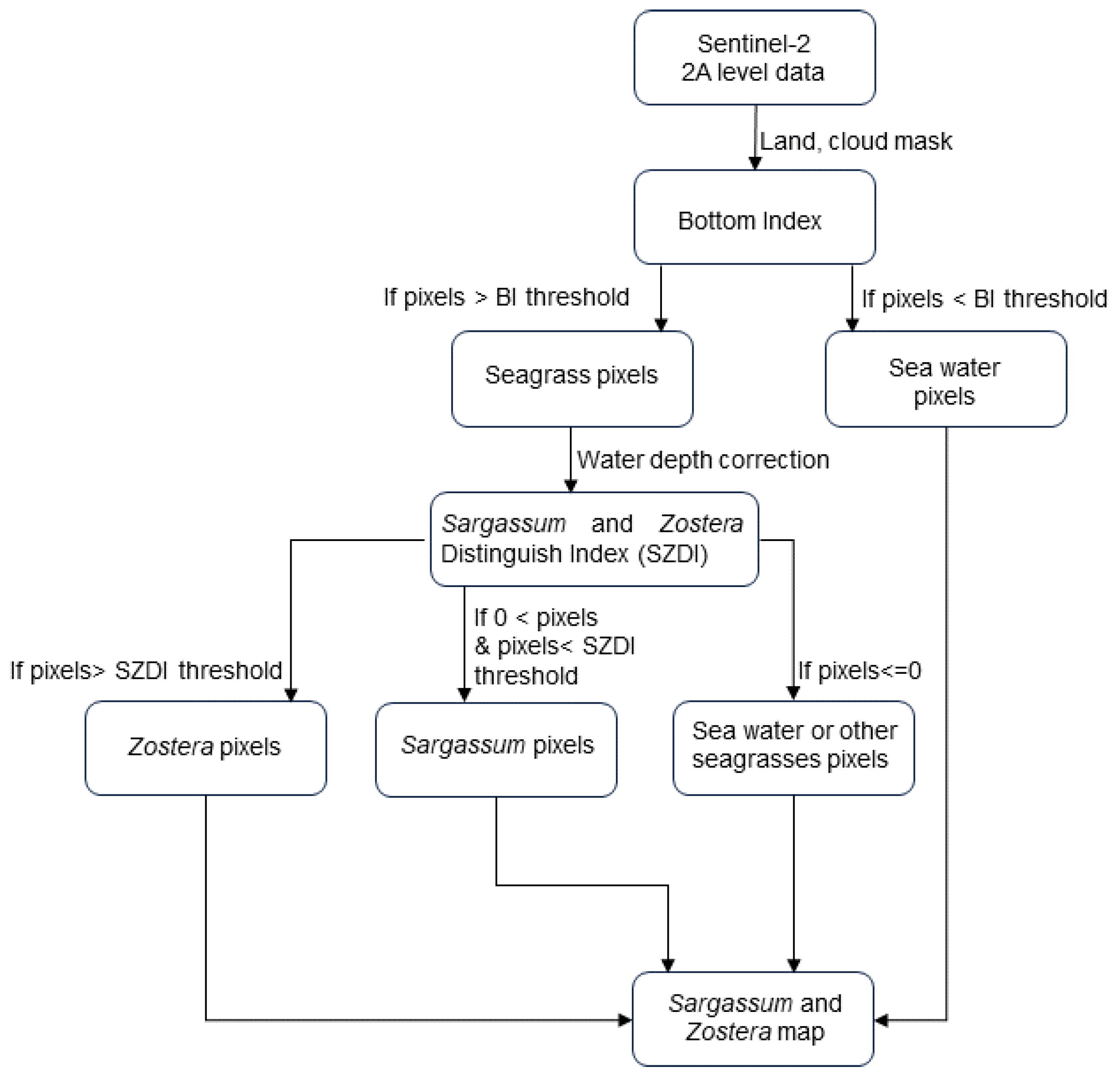
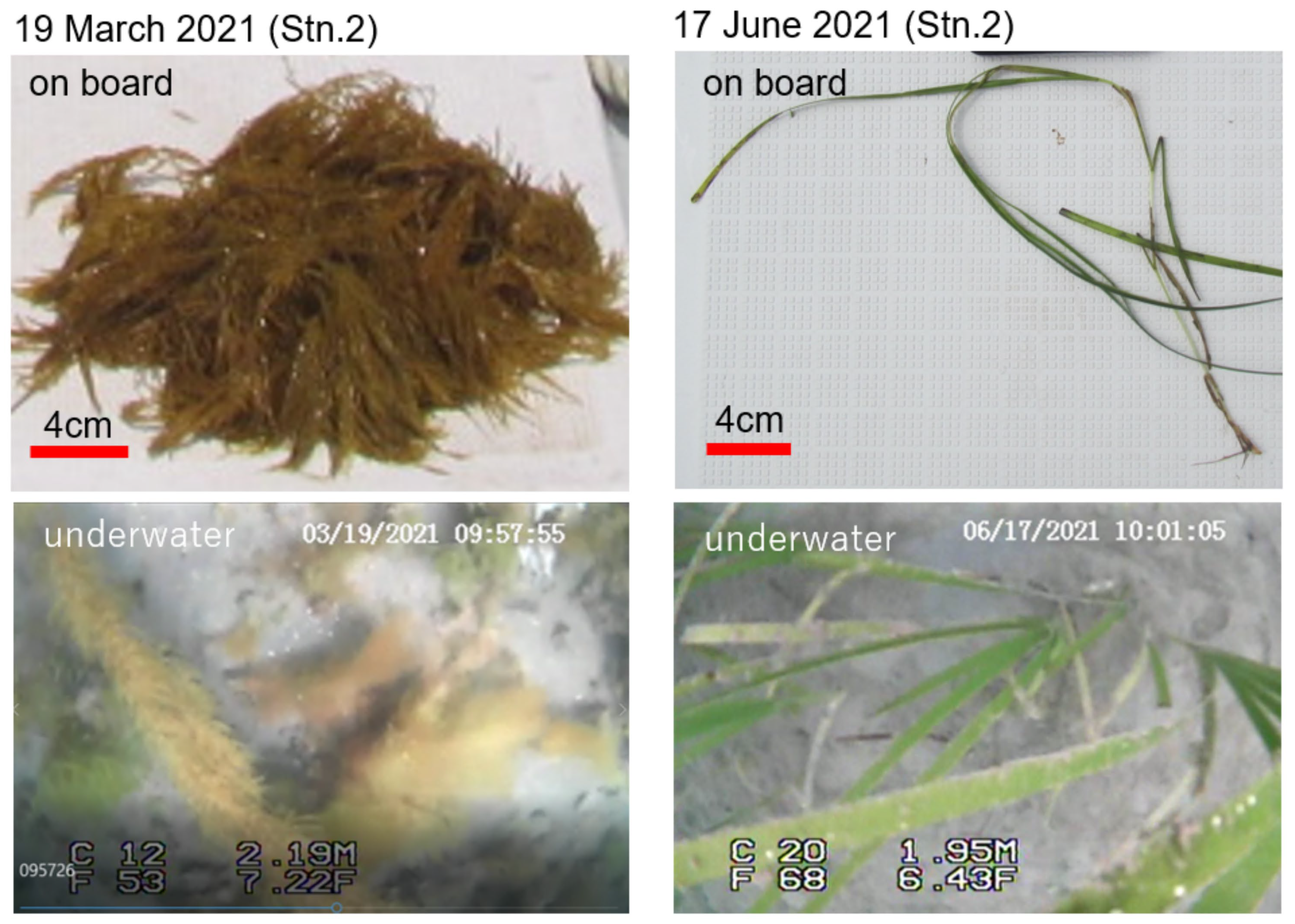

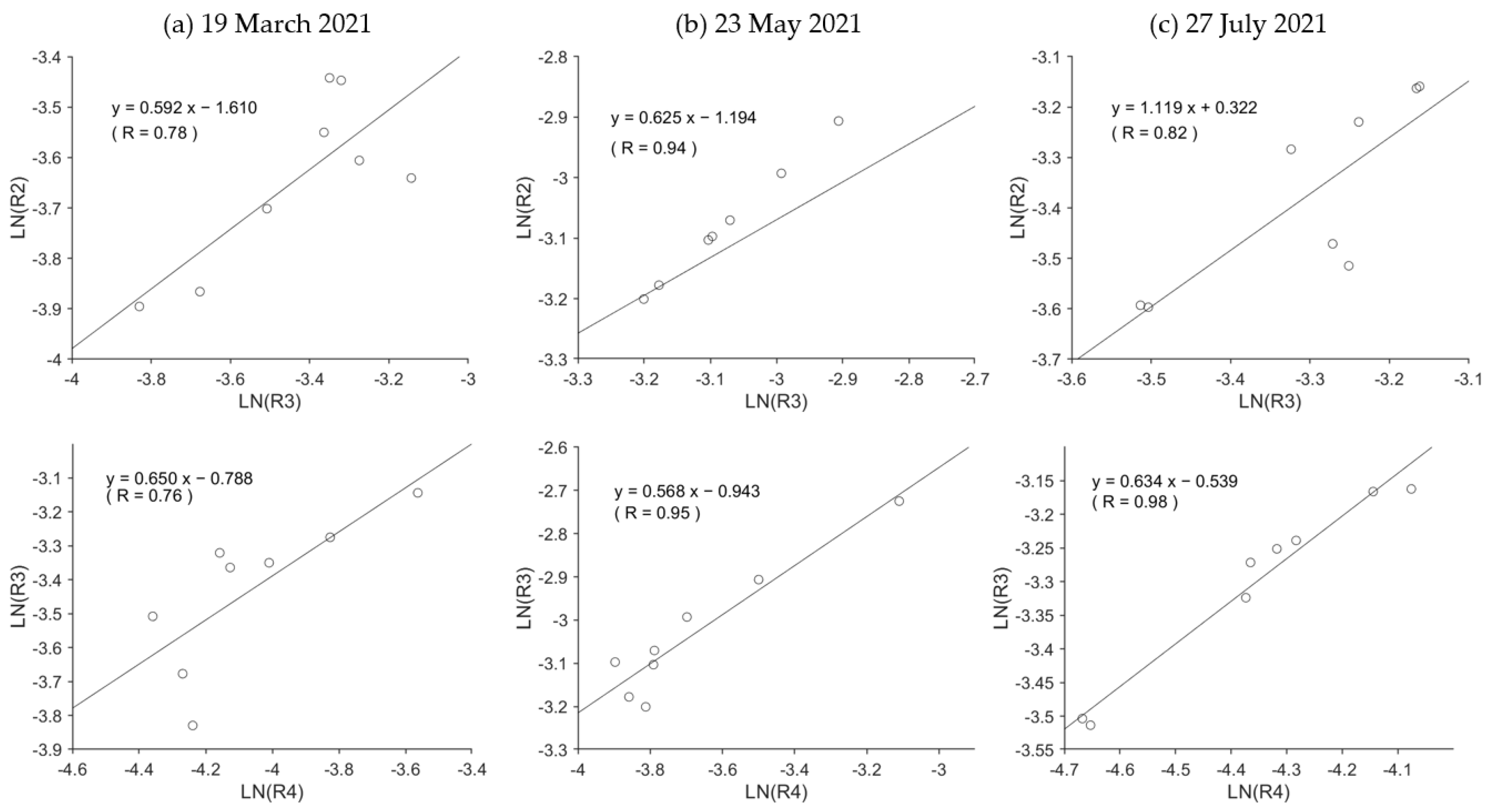
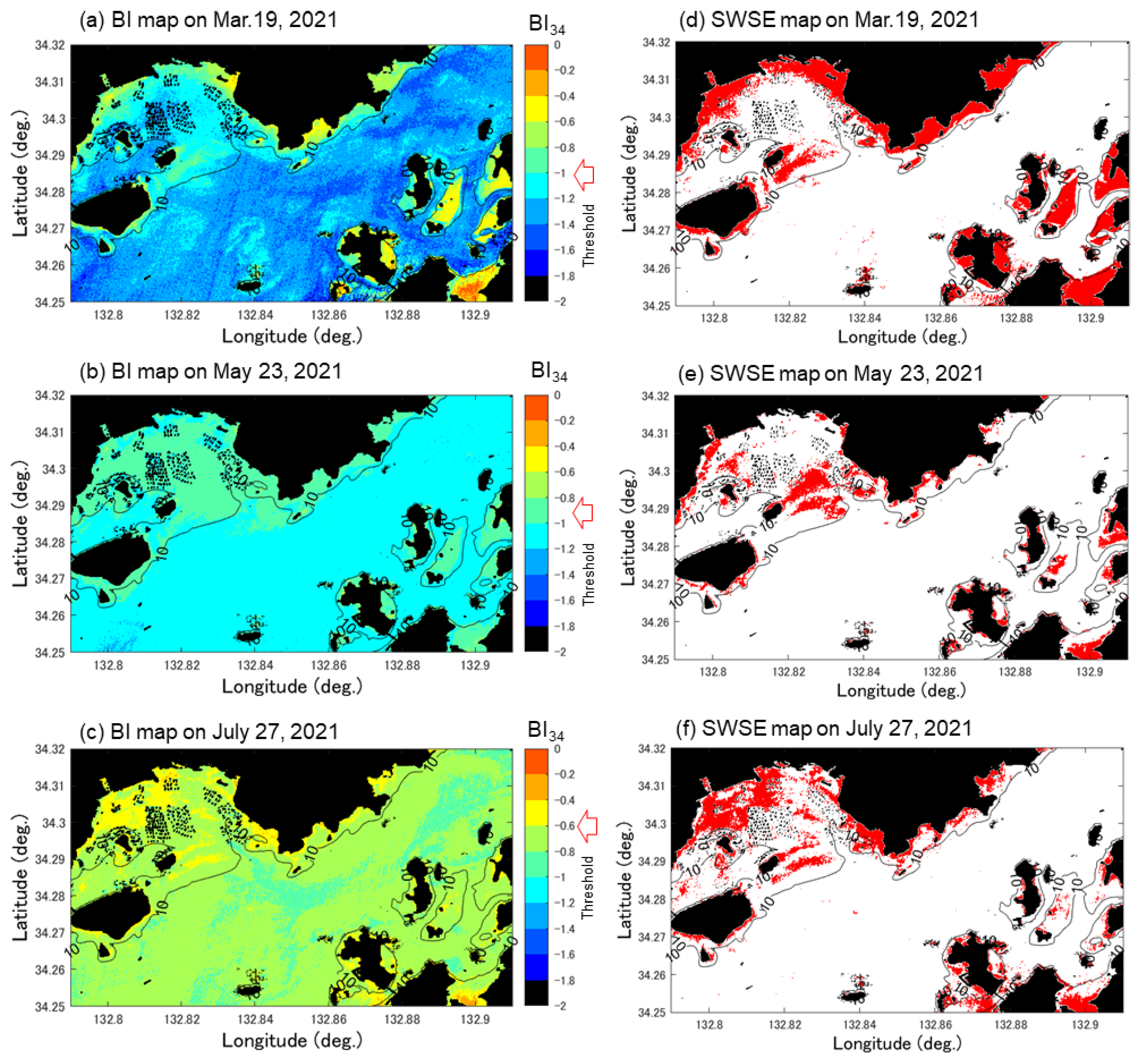
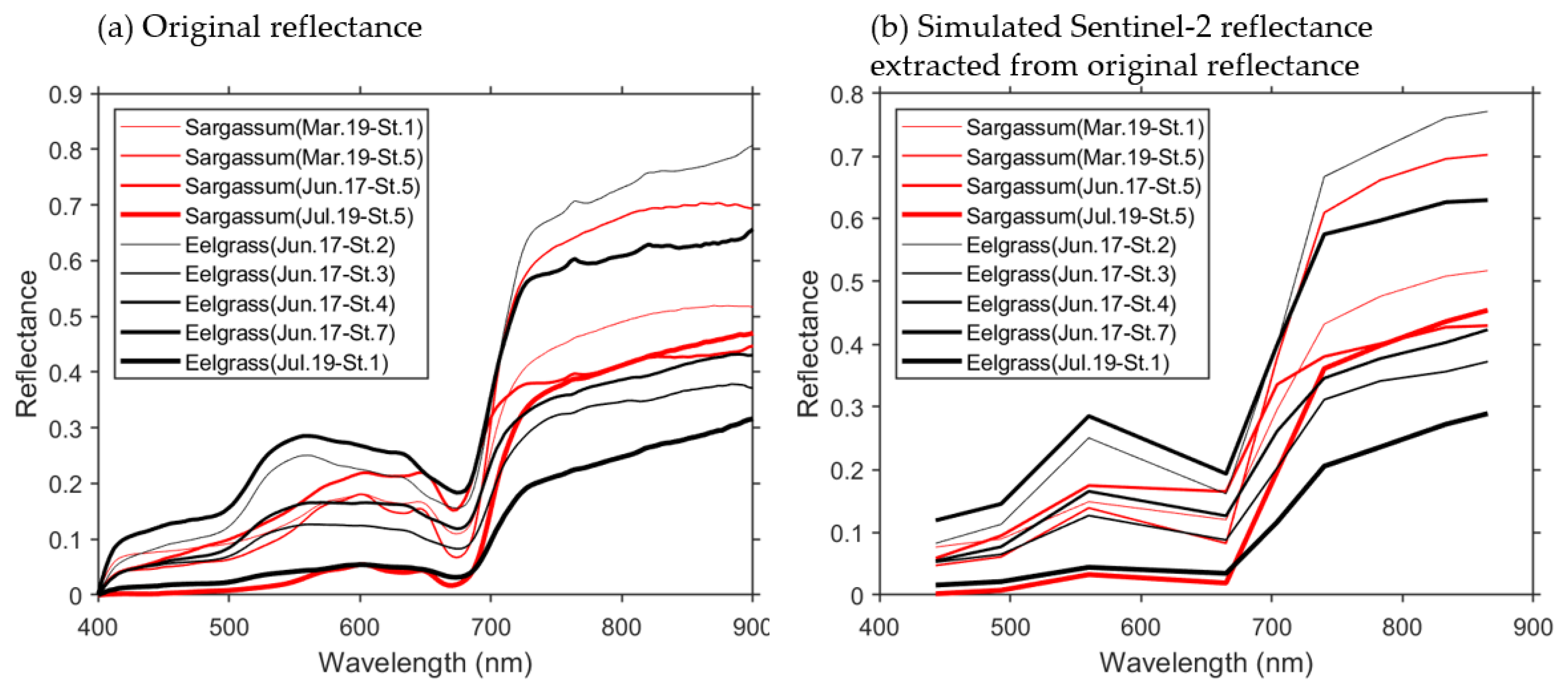
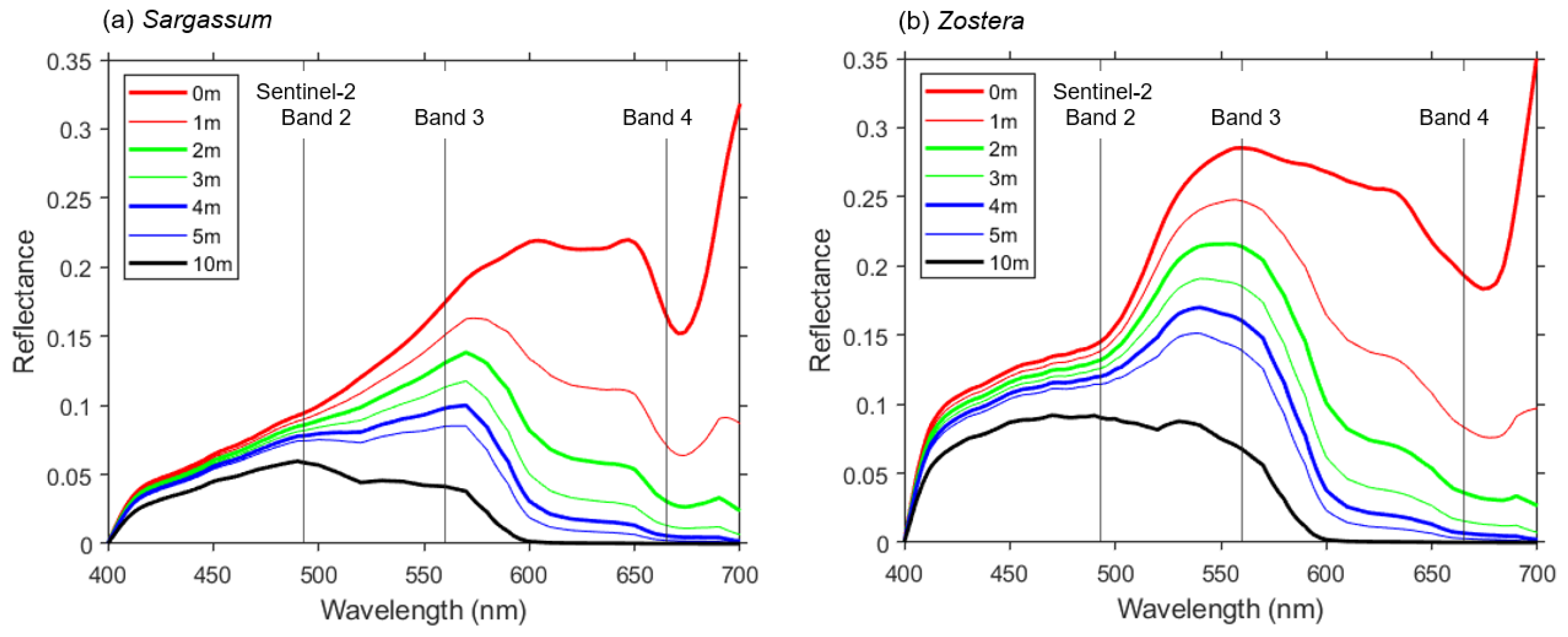

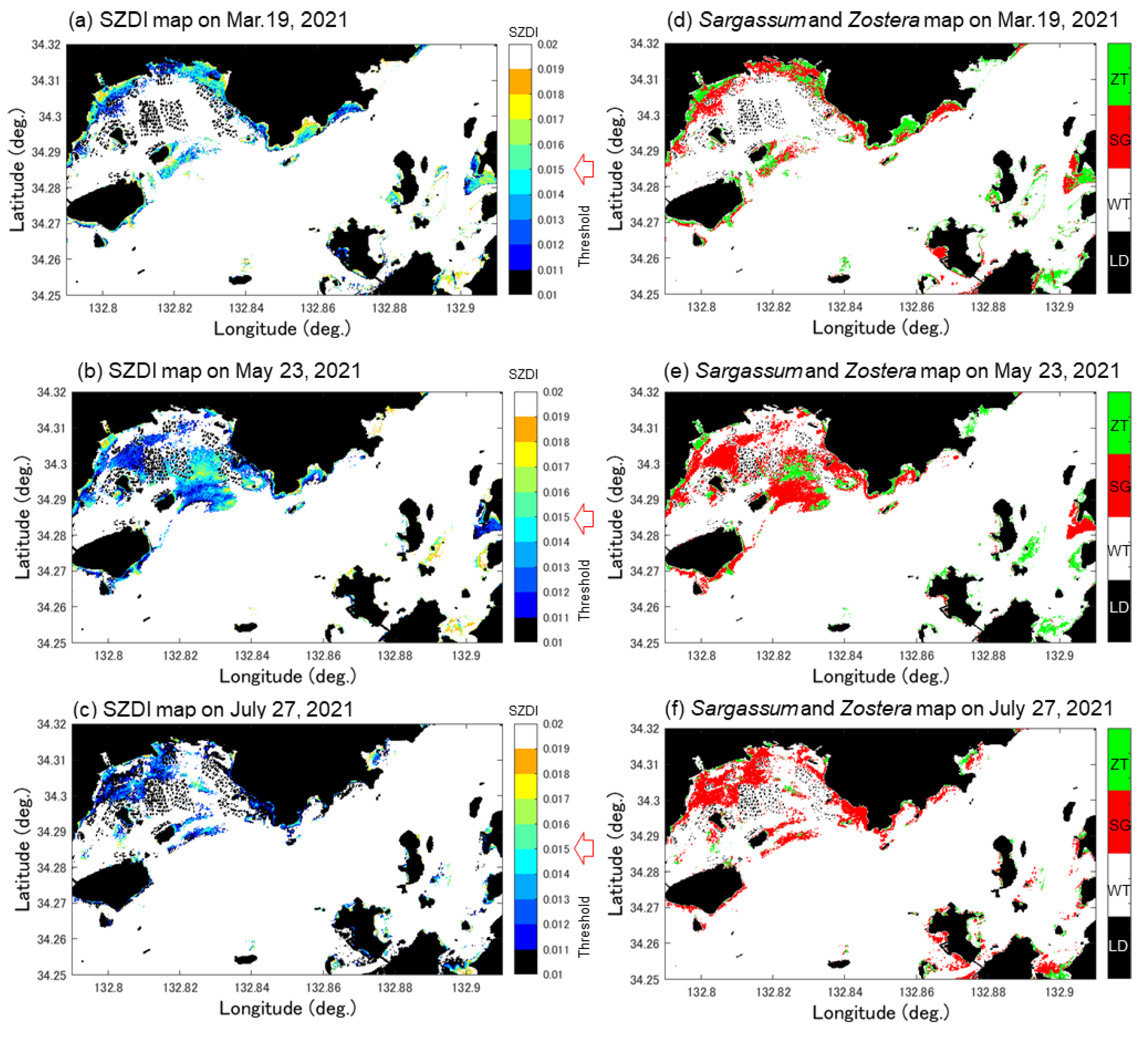

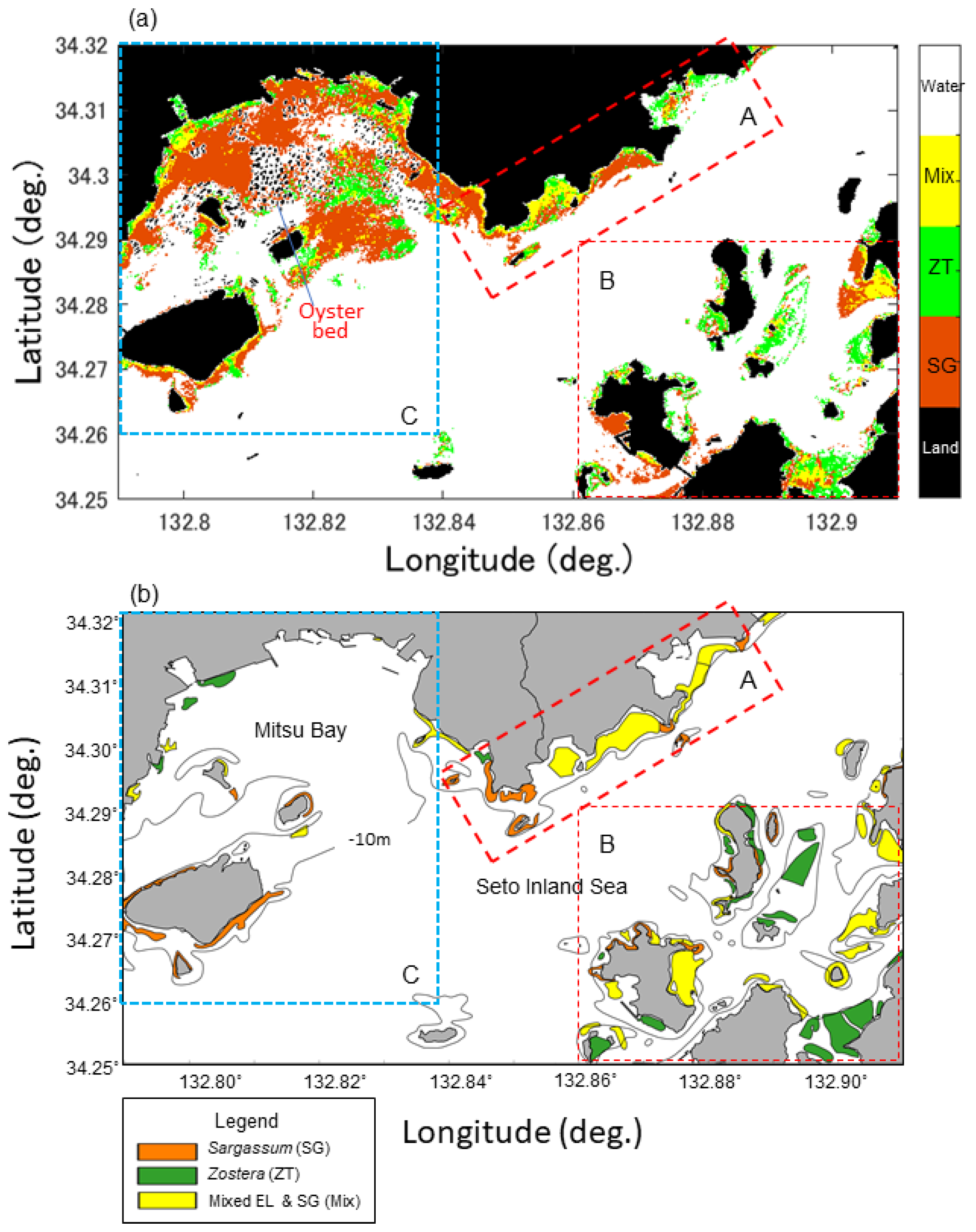
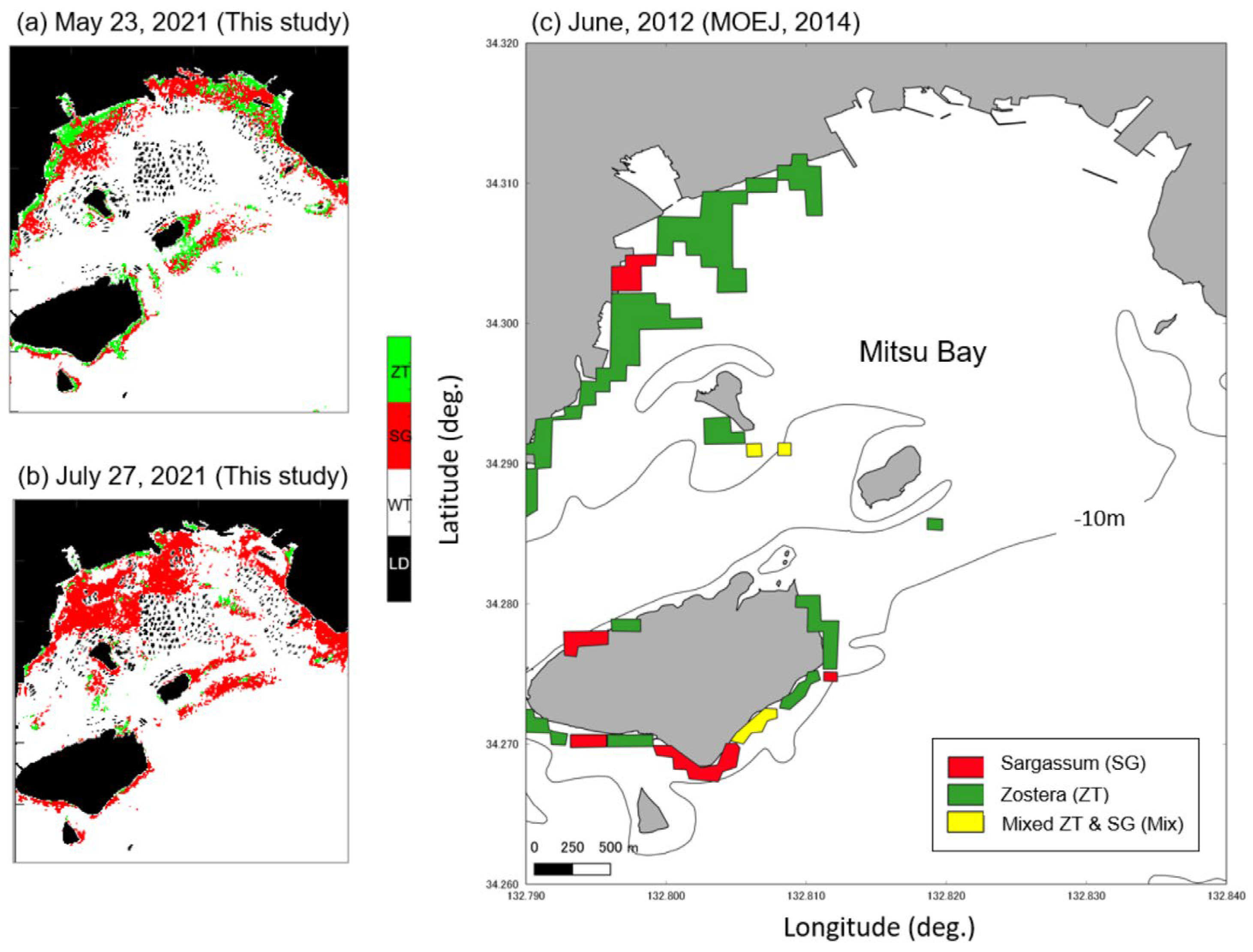

| Band | Central Wavelength | Spatial Resolution | Band | Central Wavelength | Spatial Resolution |
|---|---|---|---|---|---|
| Band 1 | 443 nm | 60 m | Band 8 | 842 nm | 10 m |
| Band 2 | 493 nm | 10 m | Band 8a | 865 nm | 20 m |
| Band 3 | 560 nm | 10 m | Band 9 | 945 nm | 60 m |
| Band 4 | 665 nm | 10 m | Band 10 | 1375 nm | 60 m |
| Band 5 | 704 nm | 20 m | Band 11 | 1610 nm | 20 m |
| Band 6 | 740 nm | 20 m | Band 12 | 2190 nm | 20 m |
| Band 7 | 783 nm | 20 m |
| No. | Sentinel-2 (S-2) | Tidal Level * (m) | |||
|---|---|---|---|---|---|
| Date | Time | Tile Number | Platform | ||
| 1 | 19 March 2021 | 10:47JST | T53SKU | Sentinel-2B | 2.37 |
| 2 | 23 May 2021 | 10:47JST | T53SKU | Sentinel-2A | 0.71 |
| 3 | 27 July 2021 | 10:47JST | T54SKU | Sentinel-2B | 3.19 |
| Sentinel-2 Band | Wavelength (nm) | ksw (m−1) | m |
|---|---|---|---|
| 2 | 493 | 0.0238 | 1.37 |
| 3 | 560 | 0.0720 | 0.45 |
| 4 | 665 | 0.4200 | 0.07 |
| Date | Rs_Band2 | Rs_Band3 | Rs_Band4 |
|---|---|---|---|
| 19 March 2021 | 0.018 | 0.165 | 0008 |
| 23 May 2021 | 0.030 | 0.050 | 0.040 |
| 27 July 2021 | 0.020 | 0.020 | 0.010 |
| Date | Stations | ||||||
|---|---|---|---|---|---|---|---|
| St. 1 | St. 2 | St. 3 | St. 4 | St. 5 | St. 6 | St. 7 | |
| 19 March | Sargassum | Other | Other | Sargassum | Sargassum | Sargassum | Unknown |
| 17 June | None | Zostera | Zostera | Zostera | Sargassum | None | Zostera |
| 19 July | Zostera | Unknown | Unknown | Other | Sargassum | Unknown | Unknown |
| 21 September | None | None | None | None | None | None | None |
Disclaimer/Publisher’s Note: The statements, opinions and data contained in all publications are solely those of the individual author(s) and contributor(s) and not of MDPI and/or the editor(s). MDPI and/or the editor(s) disclaim responsibility for any injury to people or property resulting from any ideas, methods, instructions or products referred to in the content. |
© 2023 by the authors. Licensee MDPI, Basel, Switzerland. This article is an open access article distributed under the terms and conditions of the Creative Commons Attribution (CC BY) license (https://creativecommons.org/licenses/by/4.0/).
Share and Cite
Song, S.; Sakuno, Y. Method for Distinguishing Sargassum and Zostera in the Seto Inland Sea Using Sentinel-2 Data. Water 2023, 15, 3979. https://doi.org/10.3390/w15223979
Song S, Sakuno Y. Method for Distinguishing Sargassum and Zostera in the Seto Inland Sea Using Sentinel-2 Data. Water. 2023; 15(22):3979. https://doi.org/10.3390/w15223979
Chicago/Turabian StyleSong, Shilin, and Yuji Sakuno. 2023. "Method for Distinguishing Sargassum and Zostera in the Seto Inland Sea Using Sentinel-2 Data" Water 15, no. 22: 3979. https://doi.org/10.3390/w15223979
APA StyleSong, S., & Sakuno, Y. (2023). Method for Distinguishing Sargassum and Zostera in the Seto Inland Sea Using Sentinel-2 Data. Water, 15(22), 3979. https://doi.org/10.3390/w15223979







